Comprehensive Analysis of Business Operations: John Lewis Partnership
VerifiedAdded on 2020/10/23
|10
|2468
|77
Report
AI Summary
This report provides a comprehensive analysis of business operations, using the John Lewis Partnership as a case study. It delves into the importance of accounting for organizational growth, interpreting profit and loss accounts, and examining the steps involved in team development. The report further explores the use of various motivational theories in business activities and the impact of different leadership styles on employees. Additionally, it highlights the functions of the human resource department, including recruitment, employee relations, and training & development, while also outlining key features of employment legislation. The report concludes by emphasizing the importance of adapting to the business environment and building strong strategies to achieve positive growth, highlighting the need for effective customer service and employee motivation to enhance performance and achieve organizational goals. The report is a valuable resource for understanding the intricacies of business management and operations.
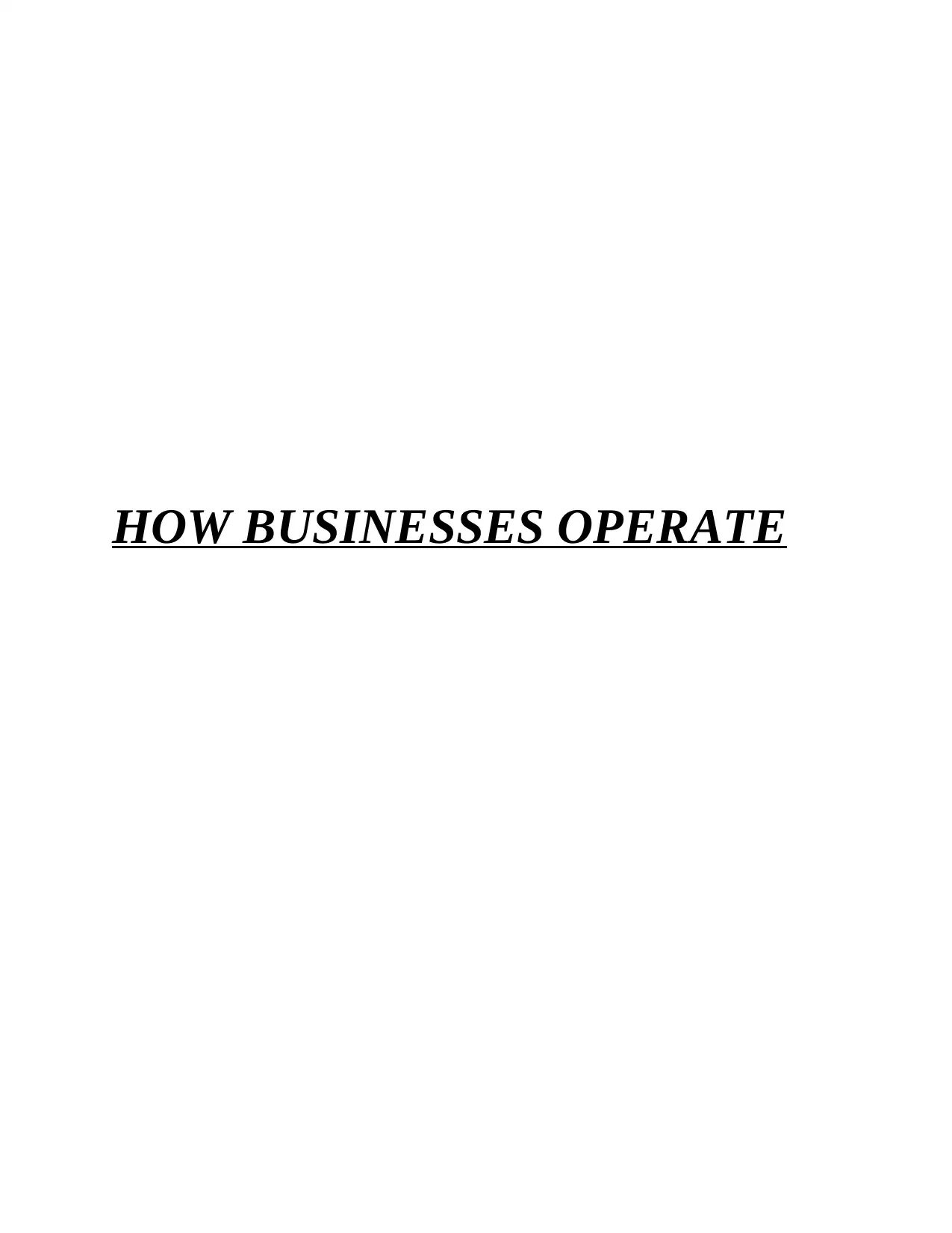
HOW BUSINESSES OPERATE
Paraphrase This Document
Need a fresh take? Get an instant paraphrase of this document with our AI Paraphraser
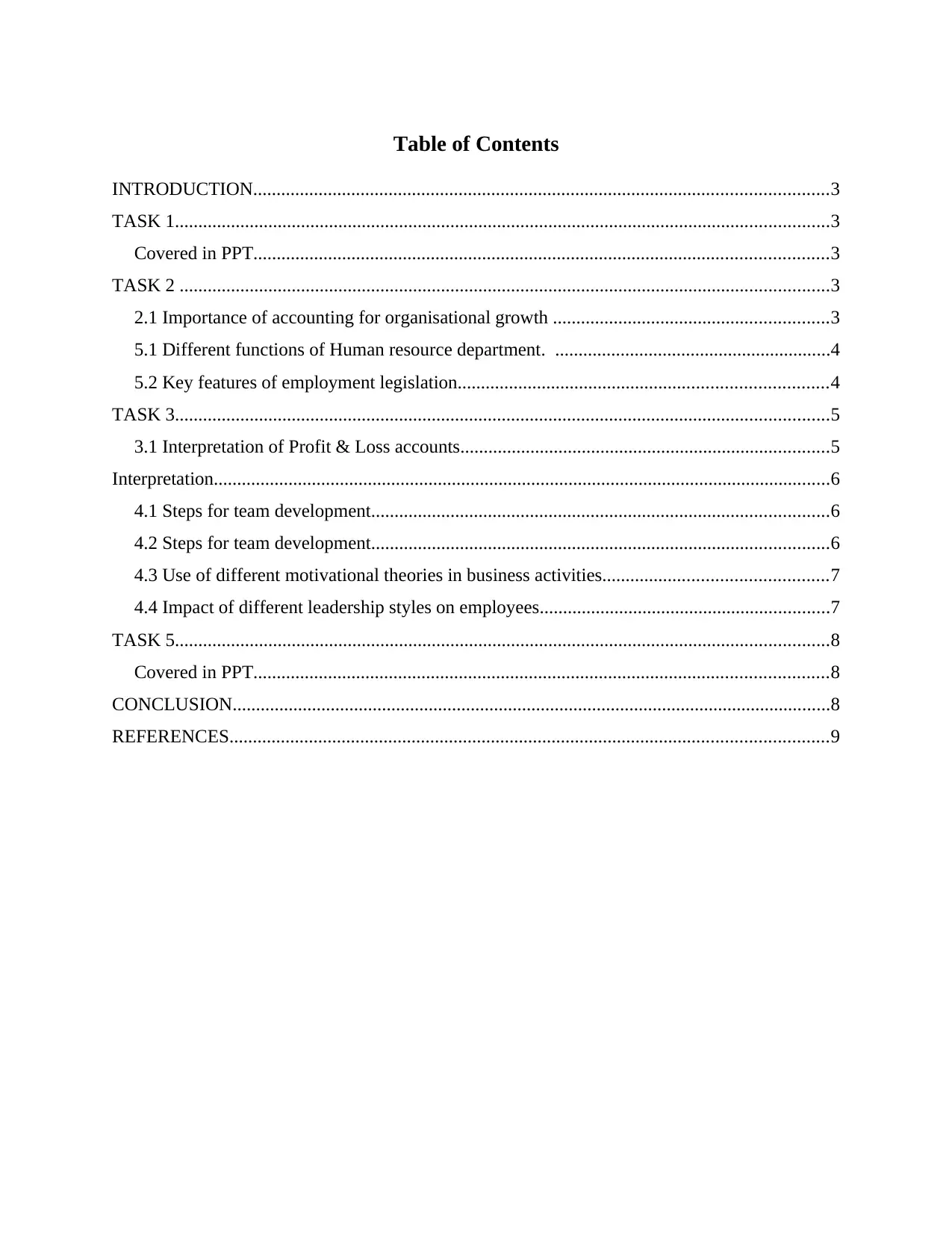
Table of Contents
INTRODUCTION...........................................................................................................................3
TASK 1............................................................................................................................................3
Covered in PPT...........................................................................................................................3
TASK 2 ...........................................................................................................................................3
2.1 Importance of accounting for organisational growth ...........................................................3
5.1 Different functions of Human resource department. ...........................................................4
5.2 Key features of employment legislation...............................................................................4
TASK 3............................................................................................................................................5
3.1 Interpretation of Profit & Loss accounts...............................................................................5
Interpretation....................................................................................................................................6
4.1 Steps for team development..................................................................................................6
4.2 Steps for team development..................................................................................................6
4.3 Use of different motivational theories in business activities................................................7
4.4 Impact of different leadership styles on employees..............................................................7
TASK 5............................................................................................................................................8
Covered in PPT...........................................................................................................................8
CONCLUSION................................................................................................................................8
REFERENCES................................................................................................................................9
INTRODUCTION...........................................................................................................................3
TASK 1............................................................................................................................................3
Covered in PPT...........................................................................................................................3
TASK 2 ...........................................................................................................................................3
2.1 Importance of accounting for organisational growth ...........................................................3
5.1 Different functions of Human resource department. ...........................................................4
5.2 Key features of employment legislation...............................................................................4
TASK 3............................................................................................................................................5
3.1 Interpretation of Profit & Loss accounts...............................................................................5
Interpretation....................................................................................................................................6
4.1 Steps for team development..................................................................................................6
4.2 Steps for team development..................................................................................................6
4.3 Use of different motivational theories in business activities................................................7
4.4 Impact of different leadership styles on employees..............................................................7
TASK 5............................................................................................................................................8
Covered in PPT...........................................................................................................................8
CONCLUSION................................................................................................................................8
REFERENCES................................................................................................................................9
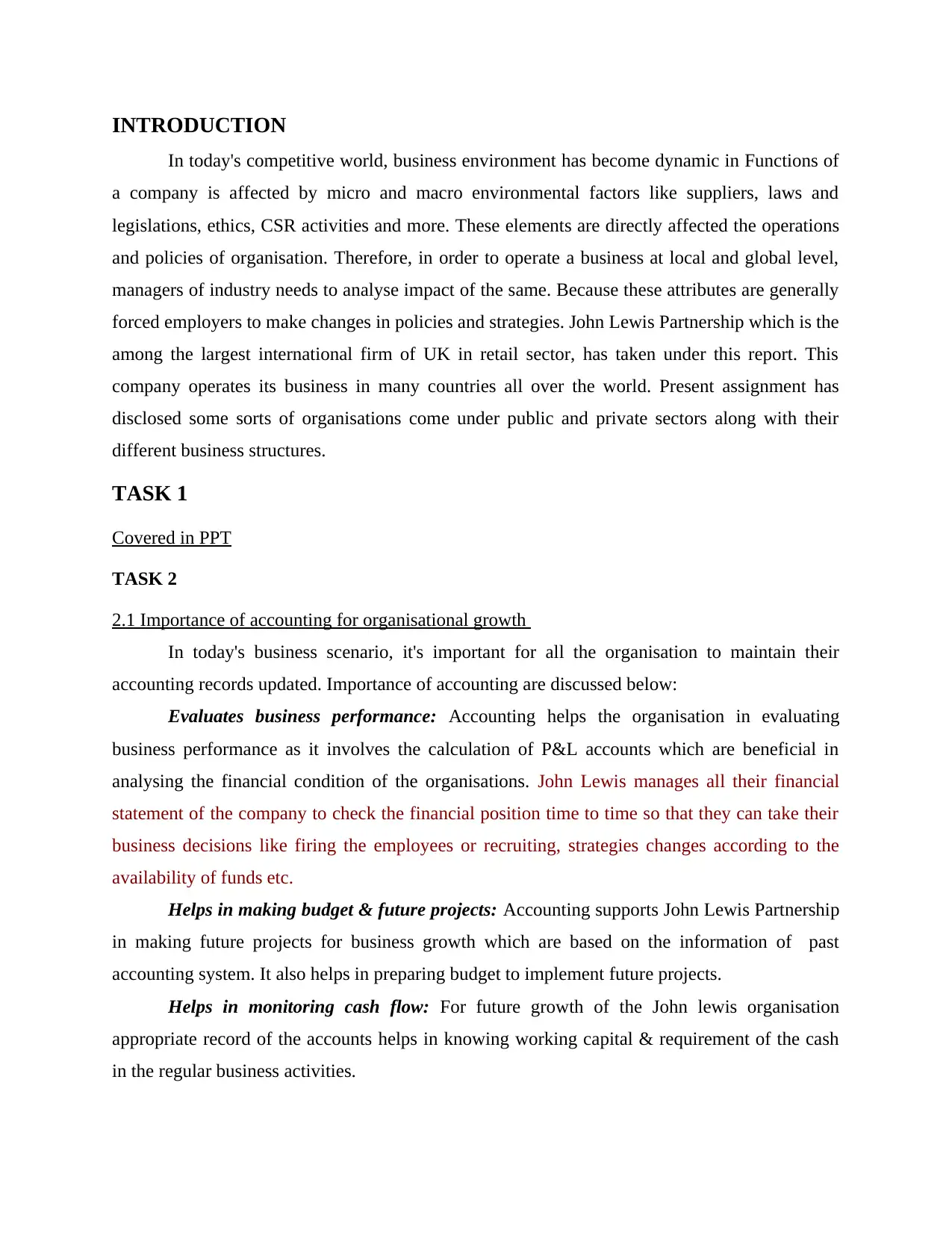
INTRODUCTION
In today's competitive world, business environment has become dynamic in Functions of
a company is affected by micro and macro environmental factors like suppliers, laws and
legislations, ethics, CSR activities and more. These elements are directly affected the operations
and policies of organisation. Therefore, in order to operate a business at local and global level,
managers of industry needs to analyse impact of the same. Because these attributes are generally
forced employers to make changes in policies and strategies. John Lewis Partnership which is the
among the largest international firm of UK in retail sector, has taken under this report. This
company operates its business in many countries all over the world. Present assignment has
disclosed some sorts of organisations come under public and private sectors along with their
different business structures.
TASK 1
Covered in PPT
TASK 2
2.1 Importance of accounting for organisational growth
In today's business scenario, it's important for all the organisation to maintain their
accounting records updated. Importance of accounting are discussed below:
Evaluates business performance: Accounting helps the organisation in evaluating
business performance as it involves the calculation of P&L accounts which are beneficial in
analysing the financial condition of the organisations. John Lewis manages all their financial
statement of the company to check the financial position time to time so that they can take their
business decisions like firing the employees or recruiting, strategies changes according to the
availability of funds etc.
Helps in making budget & future projects: Accounting supports John Lewis Partnership
in making future projects for business growth which are based on the information of past
accounting system. It also helps in preparing budget to implement future projects.
Helps in monitoring cash flow: For future growth of the John lewis organisation
appropriate record of the accounts helps in knowing working capital & requirement of the cash
in the regular business activities.
In today's competitive world, business environment has become dynamic in Functions of
a company is affected by micro and macro environmental factors like suppliers, laws and
legislations, ethics, CSR activities and more. These elements are directly affected the operations
and policies of organisation. Therefore, in order to operate a business at local and global level,
managers of industry needs to analyse impact of the same. Because these attributes are generally
forced employers to make changes in policies and strategies. John Lewis Partnership which is the
among the largest international firm of UK in retail sector, has taken under this report. This
company operates its business in many countries all over the world. Present assignment has
disclosed some sorts of organisations come under public and private sectors along with their
different business structures.
TASK 1
Covered in PPT
TASK 2
2.1 Importance of accounting for organisational growth
In today's business scenario, it's important for all the organisation to maintain their
accounting records updated. Importance of accounting are discussed below:
Evaluates business performance: Accounting helps the organisation in evaluating
business performance as it involves the calculation of P&L accounts which are beneficial in
analysing the financial condition of the organisations. John Lewis manages all their financial
statement of the company to check the financial position time to time so that they can take their
business decisions like firing the employees or recruiting, strategies changes according to the
availability of funds etc.
Helps in making budget & future projects: Accounting supports John Lewis Partnership
in making future projects for business growth which are based on the information of past
accounting system. It also helps in preparing budget to implement future projects.
Helps in monitoring cash flow: For future growth of the John lewis organisation
appropriate record of the accounts helps in knowing working capital & requirement of the cash
in the regular business activities.
⊘ This is a preview!⊘
Do you want full access?
Subscribe today to unlock all pages.

Trusted by 1+ million students worldwide
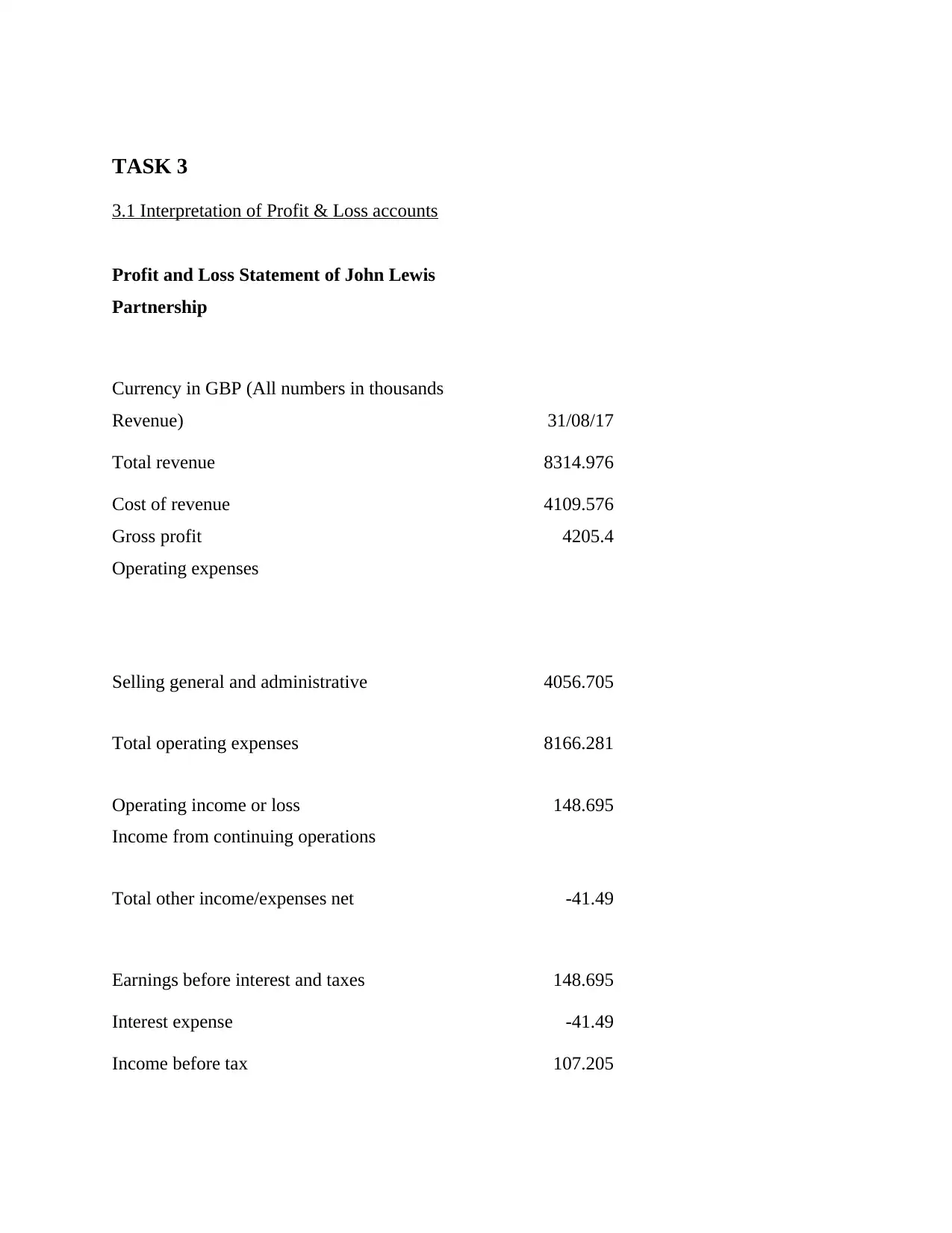
TASK 3
3.1 Interpretation of Profit & Loss accounts
Profit and Loss Statement of John Lewis
Partnership
Currency in GBP (All numbers in thousands
Revenue) 31/08/17
Total revenue 8314.976
Cost of revenue 4109.576
Gross profit 4205.4
Operating expenses
Selling general and administrative 4056.705
Total operating expenses 8166.281
Operating income or loss 148.695
Income from continuing operations
Total other income/expenses net -41.49
Earnings before interest and taxes 148.695
Interest expense -41.49
Income before tax 107.205
3.1 Interpretation of Profit & Loss accounts
Profit and Loss Statement of John Lewis
Partnership
Currency in GBP (All numbers in thousands
Revenue) 31/08/17
Total revenue 8314.976
Cost of revenue 4109.576
Gross profit 4205.4
Operating expenses
Selling general and administrative 4056.705
Total operating expenses 8166.281
Operating income or loss 148.695
Income from continuing operations
Total other income/expenses net -41.49
Earnings before interest and taxes 148.695
Interest expense -41.49
Income before tax 107.205
Paraphrase This Document
Need a fresh take? Get an instant paraphrase of this document with our AI Paraphraser
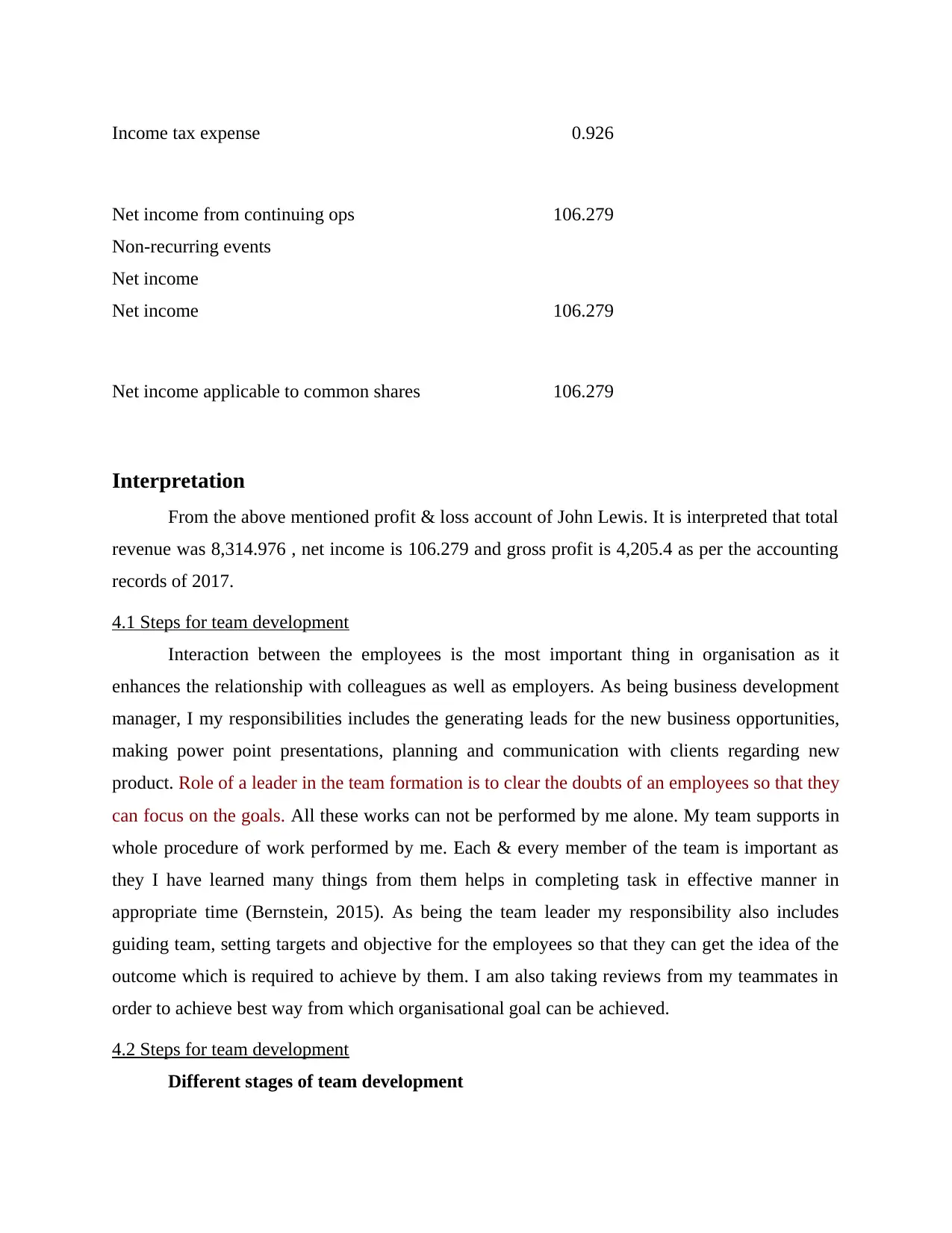
Income tax expense 0.926
Net income from continuing ops 106.279
Non-recurring events
Net income
Net income 106.279
Net income applicable to common shares 106.279
Interpretation
From the above mentioned profit & loss account of John Lewis. It is interpreted that total
revenue was 8,314.976 , net income is 106.279 and gross profit is 4,205.4 as per the accounting
records of 2017.
4.1 Steps for team development
Interaction between the employees is the most important thing in organisation as it
enhances the relationship with colleagues as well as employers. As being business development
manager, I my responsibilities includes the generating leads for the new business opportunities,
making power point presentations, planning and communication with clients regarding new
product. Role of a leader in the team formation is to clear the doubts of an employees so that they
can focus on the goals. All these works can not be performed by me alone. My team supports in
whole procedure of work performed by me. Each & every member of the team is important as
they I have learned many things from them helps in completing task in effective manner in
appropriate time (Bernstein, 2015). As being the team leader my responsibility also includes
guiding team, setting targets and objective for the employees so that they can get the idea of the
outcome which is required to achieve by them. I am also taking reviews from my teammates in
order to achieve best way from which organisational goal can be achieved.
4.2 Steps for team development
Different stages of team development
Net income from continuing ops 106.279
Non-recurring events
Net income
Net income 106.279
Net income applicable to common shares 106.279
Interpretation
From the above mentioned profit & loss account of John Lewis. It is interpreted that total
revenue was 8,314.976 , net income is 106.279 and gross profit is 4,205.4 as per the accounting
records of 2017.
4.1 Steps for team development
Interaction between the employees is the most important thing in organisation as it
enhances the relationship with colleagues as well as employers. As being business development
manager, I my responsibilities includes the generating leads for the new business opportunities,
making power point presentations, planning and communication with clients regarding new
product. Role of a leader in the team formation is to clear the doubts of an employees so that they
can focus on the goals. All these works can not be performed by me alone. My team supports in
whole procedure of work performed by me. Each & every member of the team is important as
they I have learned many things from them helps in completing task in effective manner in
appropriate time (Bernstein, 2015). As being the team leader my responsibility also includes
guiding team, setting targets and objective for the employees so that they can get the idea of the
outcome which is required to achieve by them. I am also taking reviews from my teammates in
order to achieve best way from which organisational goal can be achieved.
4.2 Steps for team development
Different stages of team development
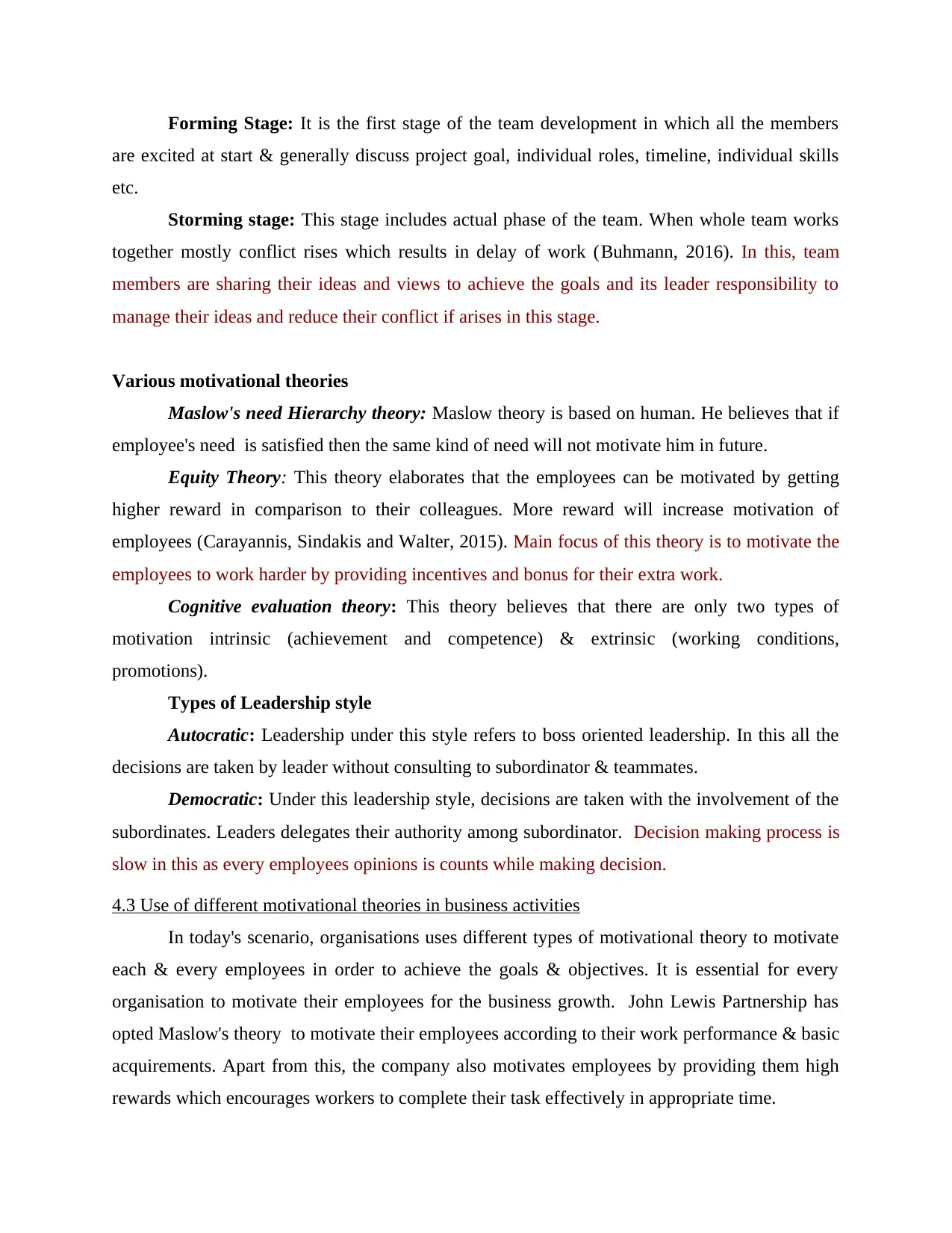
Forming Stage: It is the first stage of the team development in which all the members
are excited at start & generally discuss project goal, individual roles, timeline, individual skills
etc.
Storming stage: This stage includes actual phase of the team. When whole team works
together mostly conflict rises which results in delay of work (Buhmann, 2016). In this, team
members are sharing their ideas and views to achieve the goals and its leader responsibility to
manage their ideas and reduce their conflict if arises in this stage.
Various motivational theories
Maslow's need Hierarchy theory: Maslow theory is based on human. He believes that if
employee's need is satisfied then the same kind of need will not motivate him in future.
Equity Theory: This theory elaborates that the employees can be motivated by getting
higher reward in comparison to their colleagues. More reward will increase motivation of
employees (Carayannis, Sindakis and Walter, 2015). Main focus of this theory is to motivate the
employees to work harder by providing incentives and bonus for their extra work.
Cognitive evaluation theory: This theory believes that there are only two types of
motivation intrinsic (achievement and competence) & extrinsic (working conditions,
promotions).
Types of Leadership style
Autocratic: Leadership under this style refers to boss oriented leadership. In this all the
decisions are taken by leader without consulting to subordinator & teammates.
Democratic: Under this leadership style, decisions are taken with the involvement of the
subordinates. Leaders delegates their authority among subordinator. Decision making process is
slow in this as every employees opinions is counts while making decision.
4.3 Use of different motivational theories in business activities
In today's scenario, organisations uses different types of motivational theory to motivate
each & every employees in order to achieve the goals & objectives. It is essential for every
organisation to motivate their employees for the business growth. John Lewis Partnership has
opted Maslow's theory to motivate their employees according to their work performance & basic
acquirements. Apart from this, the company also motivates employees by providing them high
rewards which encourages workers to complete their task effectively in appropriate time.
are excited at start & generally discuss project goal, individual roles, timeline, individual skills
etc.
Storming stage: This stage includes actual phase of the team. When whole team works
together mostly conflict rises which results in delay of work (Buhmann, 2016). In this, team
members are sharing their ideas and views to achieve the goals and its leader responsibility to
manage their ideas and reduce their conflict if arises in this stage.
Various motivational theories
Maslow's need Hierarchy theory: Maslow theory is based on human. He believes that if
employee's need is satisfied then the same kind of need will not motivate him in future.
Equity Theory: This theory elaborates that the employees can be motivated by getting
higher reward in comparison to their colleagues. More reward will increase motivation of
employees (Carayannis, Sindakis and Walter, 2015). Main focus of this theory is to motivate the
employees to work harder by providing incentives and bonus for their extra work.
Cognitive evaluation theory: This theory believes that there are only two types of
motivation intrinsic (achievement and competence) & extrinsic (working conditions,
promotions).
Types of Leadership style
Autocratic: Leadership under this style refers to boss oriented leadership. In this all the
decisions are taken by leader without consulting to subordinator & teammates.
Democratic: Under this leadership style, decisions are taken with the involvement of the
subordinates. Leaders delegates their authority among subordinator. Decision making process is
slow in this as every employees opinions is counts while making decision.
4.3 Use of different motivational theories in business activities
In today's scenario, organisations uses different types of motivational theory to motivate
each & every employees in order to achieve the goals & objectives. It is essential for every
organisation to motivate their employees for the business growth. John Lewis Partnership has
opted Maslow's theory to motivate their employees according to their work performance & basic
acquirements. Apart from this, the company also motivates employees by providing them high
rewards which encourages workers to complete their task effectively in appropriate time.
⊘ This is a preview!⊘
Do you want full access?
Subscribe today to unlock all pages.

Trusted by 1+ million students worldwide
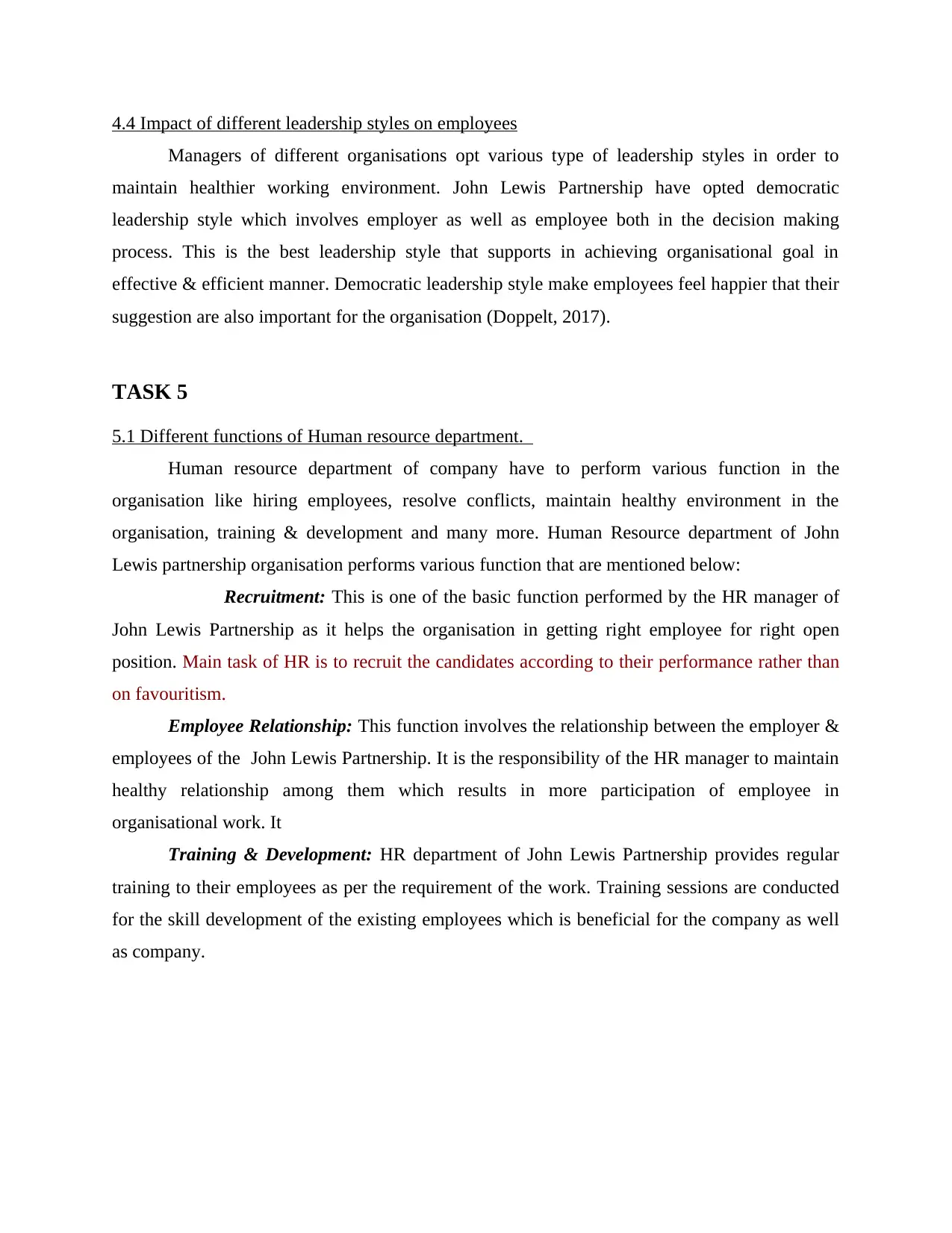
4.4 Impact of different leadership styles on employees
Managers of different organisations opt various type of leadership styles in order to
maintain healthier working environment. John Lewis Partnership have opted democratic
leadership style which involves employer as well as employee both in the decision making
process. This is the best leadership style that supports in achieving organisational goal in
effective & efficient manner. Democratic leadership style make employees feel happier that their
suggestion are also important for the organisation (Doppelt, 2017).
TASK 5
5.1 Different functions of Human resource department.
Human resource department of company have to perform various function in the
organisation like hiring employees, resolve conflicts, maintain healthy environment in the
organisation, training & development and many more. Human Resource department of John
Lewis partnership organisation performs various function that are mentioned below:
Recruitment: This is one of the basic function performed by the HR manager of
John Lewis Partnership as it helps the organisation in getting right employee for right open
position. Main task of HR is to recruit the candidates according to their performance rather than
on favouritism.
Employee Relationship: This function involves the relationship between the employer &
employees of the John Lewis Partnership. It is the responsibility of the HR manager to maintain
healthy relationship among them which results in more participation of employee in
organisational work. It
Training & Development: HR department of John Lewis Partnership provides regular
training to their employees as per the requirement of the work. Training sessions are conducted
for the skill development of the existing employees which is beneficial for the company as well
as company.
Managers of different organisations opt various type of leadership styles in order to
maintain healthier working environment. John Lewis Partnership have opted democratic
leadership style which involves employer as well as employee both in the decision making
process. This is the best leadership style that supports in achieving organisational goal in
effective & efficient manner. Democratic leadership style make employees feel happier that their
suggestion are also important for the organisation (Doppelt, 2017).
TASK 5
5.1 Different functions of Human resource department.
Human resource department of company have to perform various function in the
organisation like hiring employees, resolve conflicts, maintain healthy environment in the
organisation, training & development and many more. Human Resource department of John
Lewis partnership organisation performs various function that are mentioned below:
Recruitment: This is one of the basic function performed by the HR manager of
John Lewis Partnership as it helps the organisation in getting right employee for right open
position. Main task of HR is to recruit the candidates according to their performance rather than
on favouritism.
Employee Relationship: This function involves the relationship between the employer &
employees of the John Lewis Partnership. It is the responsibility of the HR manager to maintain
healthy relationship among them which results in more participation of employee in
organisational work. It
Training & Development: HR department of John Lewis Partnership provides regular
training to their employees as per the requirement of the work. Training sessions are conducted
for the skill development of the existing employees which is beneficial for the company as well
as company.
Paraphrase This Document
Need a fresh take? Get an instant paraphrase of this document with our AI Paraphraser
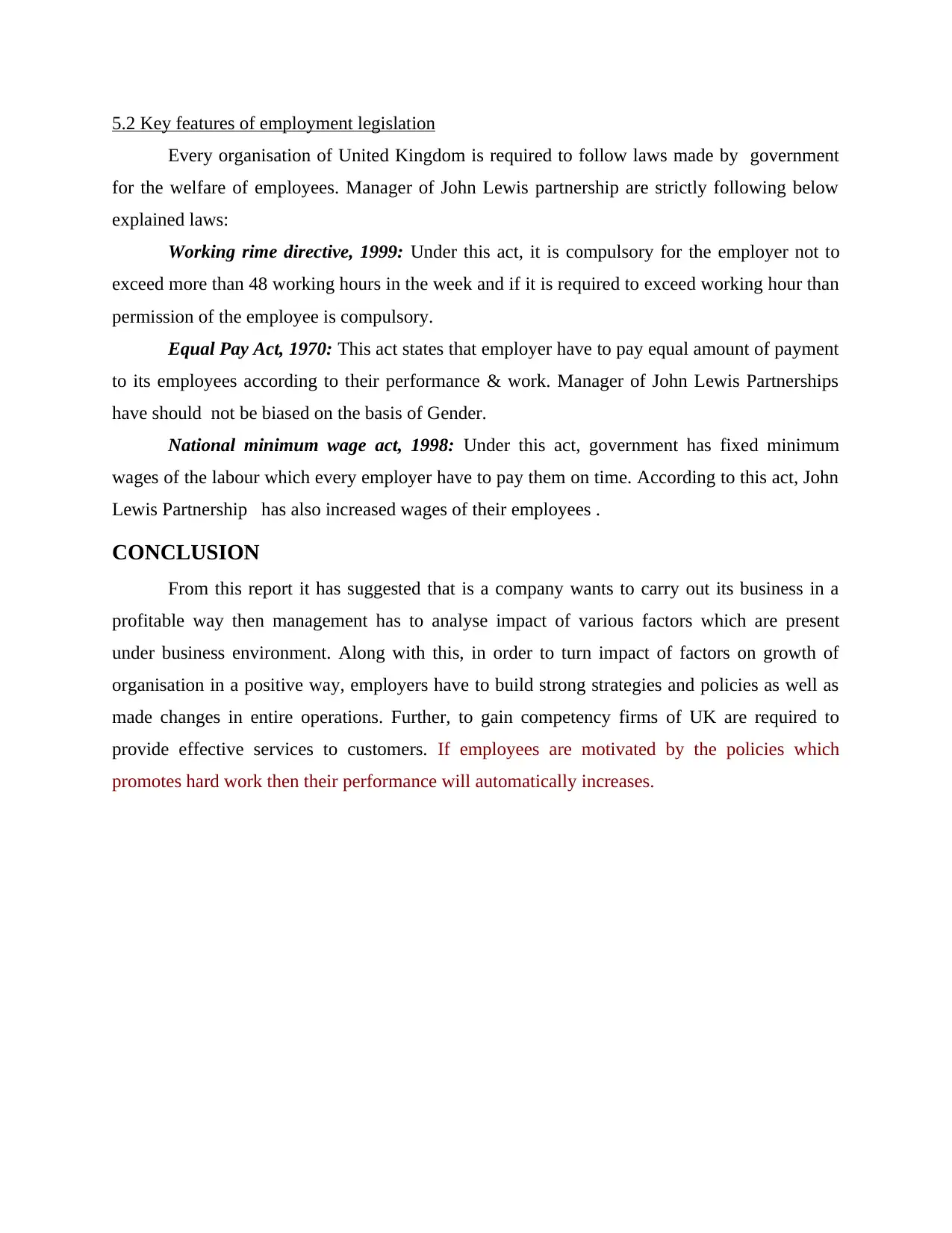
5.2 Key features of employment legislation
Every organisation of United Kingdom is required to follow laws made by government
for the welfare of employees. Manager of John Lewis partnership are strictly following below
explained laws:
Working rime directive, 1999: Under this act, it is compulsory for the employer not to
exceed more than 48 working hours in the week and if it is required to exceed working hour than
permission of the employee is compulsory.
Equal Pay Act, 1970: This act states that employer have to pay equal amount of payment
to its employees according to their performance & work. Manager of John Lewis Partnerships
have should not be biased on the basis of Gender.
National minimum wage act, 1998: Under this act, government has fixed minimum
wages of the labour which every employer have to pay them on time. According to this act, John
Lewis Partnership has also increased wages of their employees .
CONCLUSION
From this report it has suggested that is a company wants to carry out its business in a
profitable way then management has to analyse impact of various factors which are present
under business environment. Along with this, in order to turn impact of factors on growth of
organisation in a positive way, employers have to build strong strategies and policies as well as
made changes in entire operations. Further, to gain competency firms of UK are required to
provide effective services to customers. If employees are motivated by the policies which
promotes hard work then their performance will automatically increases.
Every organisation of United Kingdom is required to follow laws made by government
for the welfare of employees. Manager of John Lewis partnership are strictly following below
explained laws:
Working rime directive, 1999: Under this act, it is compulsory for the employer not to
exceed more than 48 working hours in the week and if it is required to exceed working hour than
permission of the employee is compulsory.
Equal Pay Act, 1970: This act states that employer have to pay equal amount of payment
to its employees according to their performance & work. Manager of John Lewis Partnerships
have should not be biased on the basis of Gender.
National minimum wage act, 1998: Under this act, government has fixed minimum
wages of the labour which every employer have to pay them on time. According to this act, John
Lewis Partnership has also increased wages of their employees .
CONCLUSION
From this report it has suggested that is a company wants to carry out its business in a
profitable way then management has to analyse impact of various factors which are present
under business environment. Along with this, in order to turn impact of factors on growth of
organisation in a positive way, employers have to build strong strategies and policies as well as
made changes in entire operations. Further, to gain competency firms of UK are required to
provide effective services to customers. If employees are motivated by the policies which
promotes hard work then their performance will automatically increases.
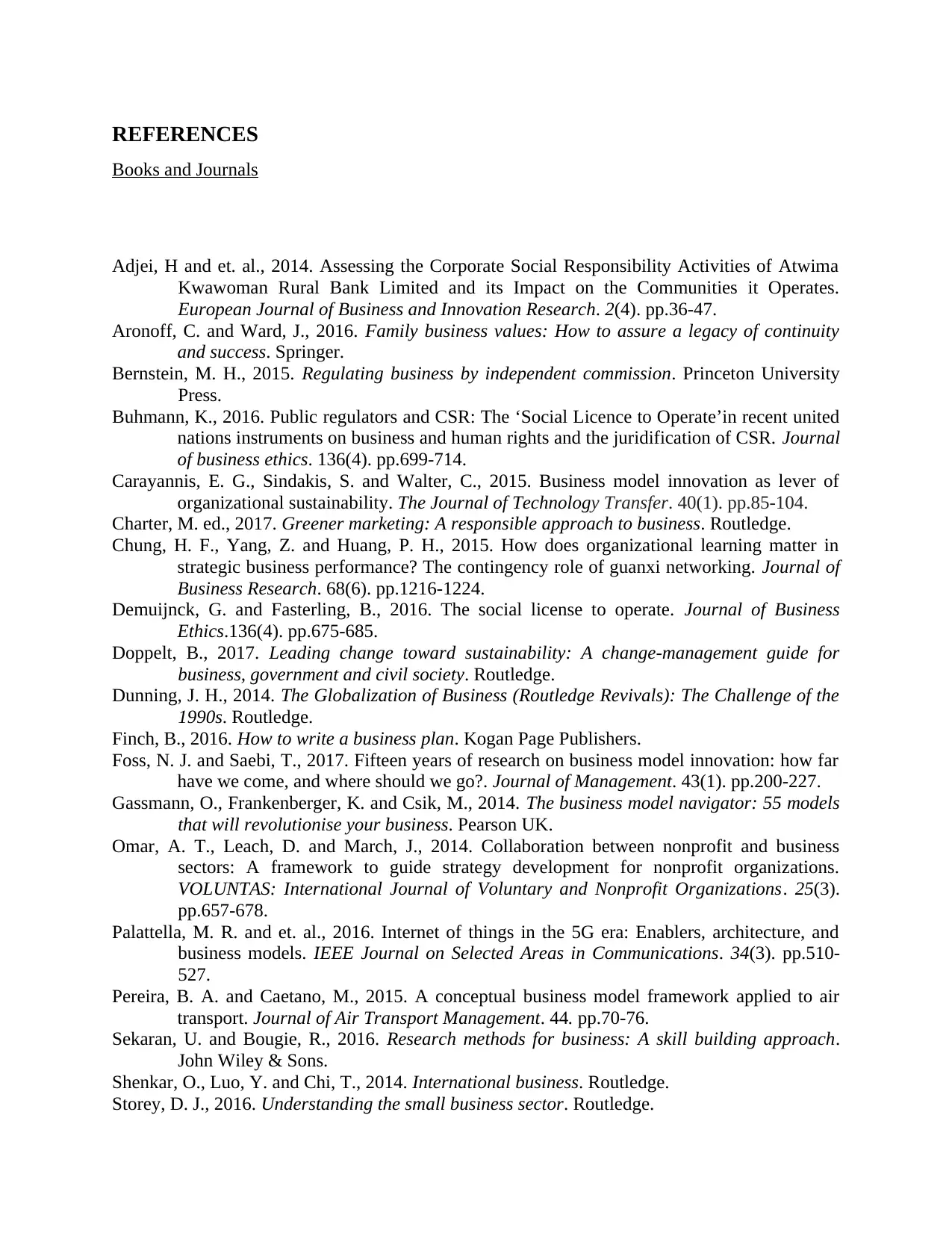
REFERENCES
Books and Journals
Adjei, H and et. al., 2014. Assessing the Corporate Social Responsibility Activities of Atwima
Kwawoman Rural Bank Limited and its Impact on the Communities it Operates.
European Journal of Business and Innovation Research. 2(4). pp.36-47.
Aronoff, C. and Ward, J., 2016. Family business values: How to assure a legacy of continuity
and success. Springer.
Bernstein, M. H., 2015. Regulating business by independent commission. Princeton University
Press.
Buhmann, K., 2016. Public regulators and CSR: The ‘Social Licence to Operate’in recent united
nations instruments on business and human rights and the juridification of CSR. Journal
of business ethics. 136(4). pp.699-714.
Carayannis, E. G., Sindakis, S. and Walter, C., 2015. Business model innovation as lever of
organizational sustainability. The Journal of Technology Transfer. 40(1). pp.85-104.
Charter, M. ed., 2017. Greener marketing: A responsible approach to business. Routledge.
Chung, H. F., Yang, Z. and Huang, P. H., 2015. How does organizational learning matter in
strategic business performance? The contingency role of guanxi networking. Journal of
Business Research. 68(6). pp.1216-1224.
Demuijnck, G. and Fasterling, B., 2016. The social license to operate. Journal of Business
Ethics.136(4). pp.675-685.
Doppelt, B., 2017. Leading change toward sustainability: A change-management guide for
business, government and civil society. Routledge.
Dunning, J. H., 2014. The Globalization of Business (Routledge Revivals): The Challenge of the
1990s. Routledge.
Finch, B., 2016. How to write a business plan. Kogan Page Publishers.
Foss, N. J. and Saebi, T., 2017. Fifteen years of research on business model innovation: how far
have we come, and where should we go?. Journal of Management. 43(1). pp.200-227.
Gassmann, O., Frankenberger, K. and Csik, M., 2014. The business model navigator: 55 models
that will revolutionise your business. Pearson UK.
Omar, A. T., Leach, D. and March, J., 2014. Collaboration between nonprofit and business
sectors: A framework to guide strategy development for nonprofit organizations.
VOLUNTAS: International Journal of Voluntary and Nonprofit Organizations. 25(3).
pp.657-678.
Palattella, M. R. and et. al., 2016. Internet of things in the 5G era: Enablers, architecture, and
business models. IEEE Journal on Selected Areas in Communications. 34(3). pp.510-
527.
Pereira, B. A. and Caetano, M., 2015. A conceptual business model framework applied to air
transport. Journal of Air Transport Management. 44. pp.70-76.
Sekaran, U. and Bougie, R., 2016. Research methods for business: A skill building approach.
John Wiley & Sons.
Shenkar, O., Luo, Y. and Chi, T., 2014. International business. Routledge.
Storey, D. J., 2016. Understanding the small business sector. Routledge.
Books and Journals
Adjei, H and et. al., 2014. Assessing the Corporate Social Responsibility Activities of Atwima
Kwawoman Rural Bank Limited and its Impact on the Communities it Operates.
European Journal of Business and Innovation Research. 2(4). pp.36-47.
Aronoff, C. and Ward, J., 2016. Family business values: How to assure a legacy of continuity
and success. Springer.
Bernstein, M. H., 2015. Regulating business by independent commission. Princeton University
Press.
Buhmann, K., 2016. Public regulators and CSR: The ‘Social Licence to Operate’in recent united
nations instruments on business and human rights and the juridification of CSR. Journal
of business ethics. 136(4). pp.699-714.
Carayannis, E. G., Sindakis, S. and Walter, C., 2015. Business model innovation as lever of
organizational sustainability. The Journal of Technology Transfer. 40(1). pp.85-104.
Charter, M. ed., 2017. Greener marketing: A responsible approach to business. Routledge.
Chung, H. F., Yang, Z. and Huang, P. H., 2015. How does organizational learning matter in
strategic business performance? The contingency role of guanxi networking. Journal of
Business Research. 68(6). pp.1216-1224.
Demuijnck, G. and Fasterling, B., 2016. The social license to operate. Journal of Business
Ethics.136(4). pp.675-685.
Doppelt, B., 2017. Leading change toward sustainability: A change-management guide for
business, government and civil society. Routledge.
Dunning, J. H., 2014. The Globalization of Business (Routledge Revivals): The Challenge of the
1990s. Routledge.
Finch, B., 2016. How to write a business plan. Kogan Page Publishers.
Foss, N. J. and Saebi, T., 2017. Fifteen years of research on business model innovation: how far
have we come, and where should we go?. Journal of Management. 43(1). pp.200-227.
Gassmann, O., Frankenberger, K. and Csik, M., 2014. The business model navigator: 55 models
that will revolutionise your business. Pearson UK.
Omar, A. T., Leach, D. and March, J., 2014. Collaboration between nonprofit and business
sectors: A framework to guide strategy development for nonprofit organizations.
VOLUNTAS: International Journal of Voluntary and Nonprofit Organizations. 25(3).
pp.657-678.
Palattella, M. R. and et. al., 2016. Internet of things in the 5G era: Enablers, architecture, and
business models. IEEE Journal on Selected Areas in Communications. 34(3). pp.510-
527.
Pereira, B. A. and Caetano, M., 2015. A conceptual business model framework applied to air
transport. Journal of Air Transport Management. 44. pp.70-76.
Sekaran, U. and Bougie, R., 2016. Research methods for business: A skill building approach.
John Wiley & Sons.
Shenkar, O., Luo, Y. and Chi, T., 2014. International business. Routledge.
Storey, D. J., 2016. Understanding the small business sector. Routledge.
⊘ This is a preview!⊘
Do you want full access?
Subscribe today to unlock all pages.

Trusted by 1+ million students worldwide
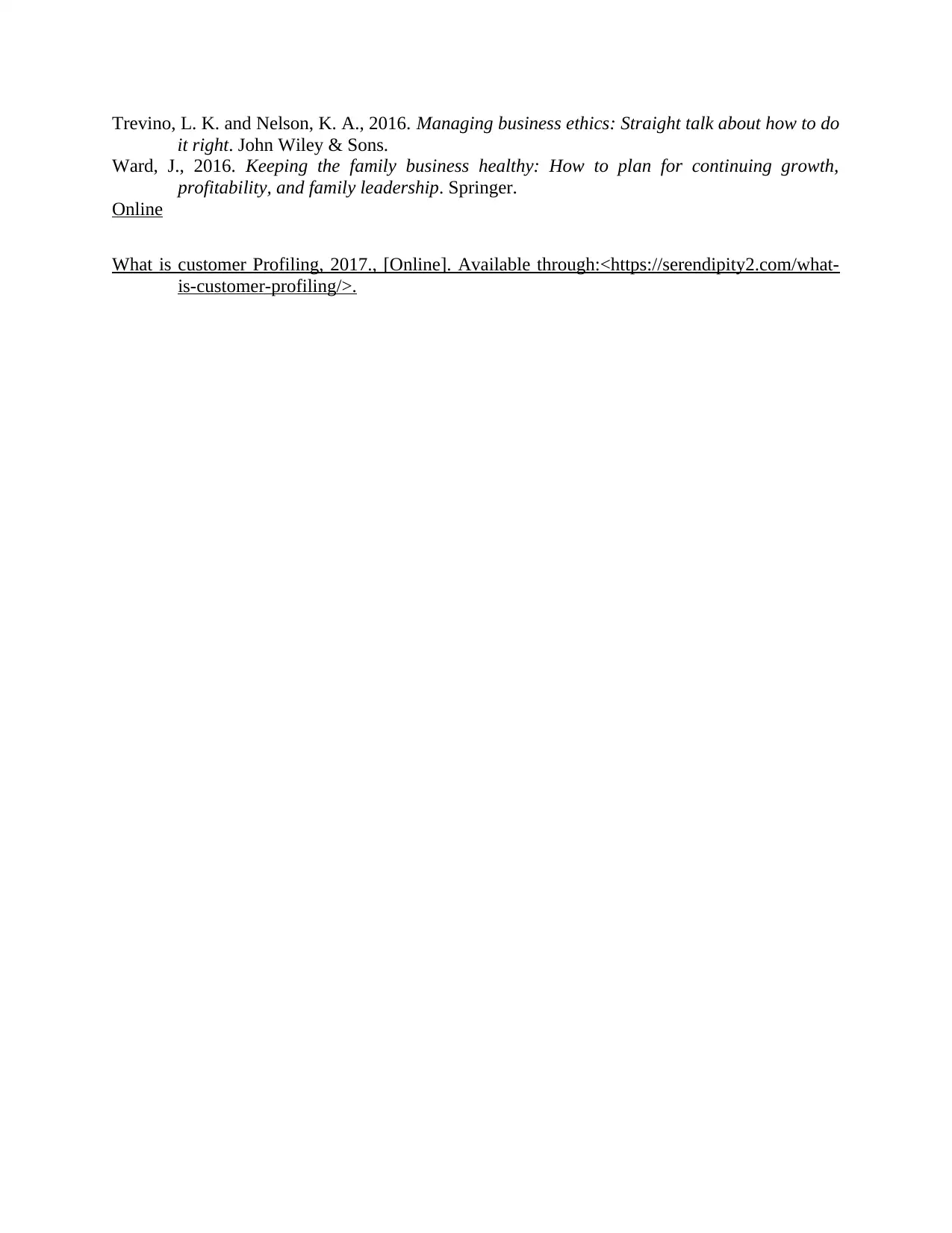
Trevino, L. K. and Nelson, K. A., 2016. Managing business ethics: Straight talk about how to do
it right. John Wiley & Sons.
Ward, J., 2016. Keeping the family business healthy: How to plan for continuing growth,
profitability, and family leadership. Springer.
Online
What is customer Profiling, 2017., [Online]. Available through:<https://serendipity2.com/what-
is-customer-profiling/>.
it right. John Wiley & Sons.
Ward, J., 2016. Keeping the family business healthy: How to plan for continuing growth,
profitability, and family leadership. Springer.
Online
What is customer Profiling, 2017., [Online]. Available through:<https://serendipity2.com/what-
is-customer-profiling/>.
1 out of 10
Related Documents
Your All-in-One AI-Powered Toolkit for Academic Success.
+13062052269
info@desklib.com
Available 24*7 on WhatsApp / Email
![[object Object]](/_next/static/media/star-bottom.7253800d.svg)
Unlock your academic potential
Copyright © 2020–2025 A2Z Services. All Rights Reserved. Developed and managed by ZUCOL.





